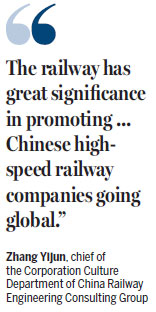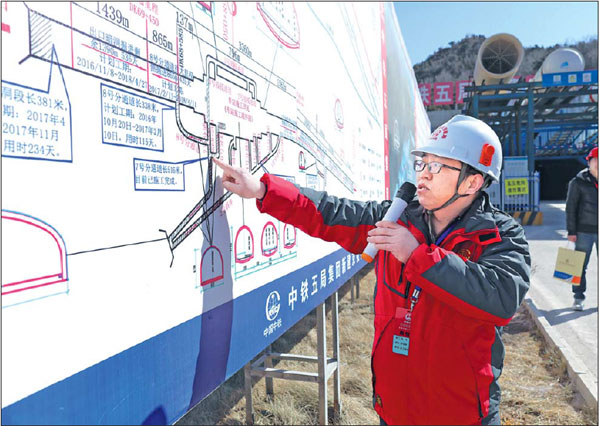Beijing-Zhangjiakou line to boost regional growth
New high-speed rail to promote coordinated development and support Winter Olympic traffic
A new Beijing-Zhangjiakou high-speed railway is set to be completed by the end of 2019, according to its designer, China Railway Engineering Consulting Group.
Roads linking Beijing and Zhangjiakou, the two co-hosts of the 2022 Winter Olympics, play a major role in transportation between the two cities.
Once the new railway with a design speed of 350 kilometers per hour is completed, travel time between the cities will be slashed from three hours to 50 minutes, said Qiao Junfei, deputy general engineer of the group.
It will operate up to 170 pairs of high-speed trains per day. Each of the trains will be capable of carrying 1,200 passengers in 2019.
By 2022, the railway will be able to transport more than 6,000 people per hour, Qiao said.

The project, which kicked of in early 2016, involves a new 174-kilometer line with 10 stations starting from Beijing's North Railway Station and passing through the municipality's Haidian and Changping districts.
After passing the Yanqing station, it enters into the territory of Hebei province and continues past the Guanting Reservoir, Huailai county, Xiahuayuan district, Xuanhua district and terminates at Zhangjiakou's North Railway Station.
Zhangjiakou's North Railway Station will also connect to the Hohhot-Zhangjiakou and Datong-Zhangjiakou high-speed railways that are currently under construction, said Cheng Jingbo, deputy manager of Beijing-Zhangjiakou Railway Co, which is in charge of the railway's management and construction.
After those railway programs are finished, it will form a traffic network linking the main areas of Northwest and North China, such as Baotou, Yinchuan and Lanzhou, according to Cheng.
Another station in Zhangjiakou, the Xiahuayuan station on the Beijing-Zhangjiakou line, will become the departure station of the Chongli railway, which terminates at Taizicheng, the 2022 Winter Olympics venue for snow sports.
"One significance of the Beijing-Zhangjiakou high-speed railway is its representation of the coordinated development of the Beijing-Tianjin-Hebei region," Cheng said.
The railway will combine Beijing's advantages in science, technology and finance with the environmental and tourism resources in Zhangjiakou. It will also meet the transportation needs of the 2022 Winter Olympics, local officials said.
Via the new railway, it will take a mere 20 minutes to travel from Beijing's North Railway Station to Yanqing, the 2022 Winter Olympics venue for alpine skiing, bobsleigh and luge.
"The railway has great significance in promoting the Chinese railway technical standards system and Chinese high-speed railway companies going global," said Zhang Yijun, chief of the Corporation Culture Department of China Railway Engineering Consulting Group.
"It is the first ballast high-speed track ever designed to reach speeds of 350 km/h all over the world," Zhang said.
The ballast high-speed track is more economical than others, and performs well in reducing noise and protecting the environment, Qiao Junfei said.
The groundbreaking "Bridge (2013)-2321" series beam was specially developed to counteract potential damage to bridge structures caused by high-speed trains.
New technology was also used to minimize the impact of bridge construction on existing transport. The "pier-top spin construction approach" was used when crossing over the Beijing-Tibet highway and Datong-Qinhuangdao railway.
The Badaling Great Wall station, one of the 10 stations on the railway, is right beneath the Badaling Great Wall heritage site.
The station has a maximum burial depth of 102 meters and covers 36,000 square meters of construction area, making it the largest and most deeply-buried underground railway station in the world.
The station is the first to use a laminated-layer structure for inbound and outbound tunnels, which completely separates inbound and outbound passengers and creates a more balanced space arrangement.
The construction team used precision explosion methods to protect the Great Wall's invaluable heritage. Special procedures were also used to protect nearby water resources, according to Lyu Gang, a senior engineer at China Railway Engineering Consulting Group.
"We showed our great respect for humanity and nature during the whole process of construction," Lyu said.
In 1905, construction on the old Beijing-Zhangjiakou railway started under the supervision of noted railway engineer Zhan Tianyou, marking the first railway line independently designed, built and operated by the Chinese.
A number of innovative engineering approaches were adopted in the construction of the railway such as "shaft excavation" and "Y-shaped routes" on mountains.
With a total length of 201.2 km and design speed of 35 km/h, the railway was put into operation in December 1909. Its Qinglongqiao station is the last original station still operating today.
The new Beijing-Zhangjiakou high-speed railway will pass beneath right through the "Y-shaped routes" of the old railway.
liyou@chinadaily.com.cn
|
Luo Duhao, chief engineer of the Beijing-Zhangjiakou Railway Project Department of China Railway No 5 Engineering Group, briefs media representatives on the Beijing-Zhangjiakou high-speed railway currently under construction.Zhu Xingxin / China Daily |
(China Daily 03/07/2017 page8)















